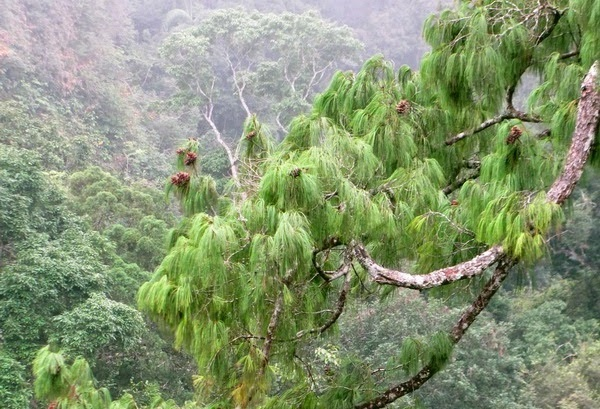

29/06/2016
The year of 2014 is assessed to be a very successful year for biology scientists. During 2012 - 2013, about 100 new species were discovered in Viet Nam. However, only in 2014, according to estimates of scientists from the Institute of Ecology and Biological Resources (Viet Nam Academy of Science and Technology), additional 126 new species were discovered in Viet Nam, a 26% increase compared to period 2012 - 2013. The Vietnam Environment Administration Magazine has had an interview with Dr. Nguyen Duc Anh, Institute of Ecology and Biological Resources, a member of Biodiversity and Conservation of Vietnam (BIODIVN) on this topic.
 |
|
Pinus cernua was discovered in Son La |
Can you tell us how does the discovery of 126 new species in Viet Nam play the role to the environment and human lives?
Dr. Nguyễn Đức Anh: Biodiversity plays important roles to the environment and human lives, ensuring ecosystem functions, supplying essential materials such as food, medicine, precious genetic resources of plants and animals, etc. The higher biodiversity, the more insurance of the sustainability of ecosystems and human lives, particularly in the context of climate change.
Viet Nam is one of countries that have high biodiversity in the world with identified 19,000 fauna species and approximate 14,000 flora species and the number is still increasing as each year hundreds of new species from Viet Nam are introduced to the science world.
With efforts and ambitions by scientists of Viet Nam, the discovery of new species has provided valuable information to the flora and fauna system, clarifying biodiversity and supplying scientific reference for studying of phylogenetic relationship, evolution and conservation.
Can you tell us, what are the main newly discovered species?
Dr. Nguyễn Đức Anh: Statistics of the BIODIVN group is based on publications in national and international scientific magazines in 2014. Accordingly, 80 fauna species and 46 flora and fungi species in Viet Nam were introduced to the science world in recent years.
For fauna species, 80 new species were published, mostly belonging to insects (accounting for 64%), amphibians (making up 16%) and others such as reptiles, fish, paleontology, crustaceans, molluscs and mammals (about from 2 to 5%). Of which, 45% of newly discovered species is in the North, 43% in the South and only 12% from the Central.
Currently, it is difficult to discover new mammals in Viet Nam, but scientists has just discovered two new mammal species, Hypsugo dolichodon (Dơi muỗi) in Dong Nai and Chiromyscus thomasi (Chuột cây) in Son La. Particularly, it is the discovery of ancient (extinct) mammals in Viet Nam. Scientists have published three ancient mammal species from fossil samples collected in Na Duong, Lang Son including: Epiaceratherium naduongense (Na Duong rhino), Bakalovia orientalis (Eastern coal beast) and Planktophaga minuta (ancient freshwater fish).
Regarding flora, fungi and lichens, of 46 newly discovered flora, fungi and lichens species, 50% is in the South, 33% in the North and 17% in the Central. Particularly, the concentrated research in Lam Dong shown surprising results with 14 published flora species, accounting for 30.4% of the total discovered species. Almost all new flora species are shrubs making up 30%, the remaining is timber trees, herbaceous plants and vines making up 26%, 17%, and 7%, respectively.
The discovery of Pinus cernua is assessed to be the most impressive result of the botany sector because there haven’t been any new discoveries of pines in many years.
It can be said that the year of 2014 is considered as a successful year of biology scientist. Can you tell us the reasons for this success?
Dr. Nguyễn Đức Anh: These achievements are thanks to different reasons, firstly scientists focus on small-size biological groups (insects, shrubs), which were paid less attention before. Investigation, studies and researches are carried out by Vietnamese scientists in collaboration with international colleagues and financially supported by international organizations and the Government of Viet Nam.
However, the discovery of new species in Viet Nam also shows new challenges for biodiversity protection and conservation. Newly discovered biological species have a narrow distribution range and the extinction threat is high, such as, reptiles, amphibians, pine trees, etc. Deforestation, land use change and overexploitation of biological resources are main threats to habitats of newly discovered species in particular and other species in general. Threatened habitat is the reason causing these species to be likely moved away from the ecosystems.
In 2015, it is expected that new conservation policies promulgated by the Government such as the national biodiversity master plan, natural timber exploitation ban, etc. will have positive impacts on the protection of ecosystems and species habitats. At the same time, with efforts of scientists, the number of newly discovered species in 2015 will not only be at 126 as it is in 2014.
Thank you for this conversation!
Nguyễn Hằng (Interviewed)